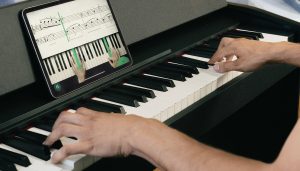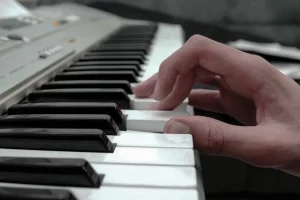The piano trill is a fascinating and intricate aspect of piano playing that has enchanted both players and listeners alike. This musical element, steeped in history and artistry, is more than just a technique; it’s a gateway to understanding the nuances and expressiveness inherent in piano music. In this comprehensive exploration, we delve into the world of piano trills, uncovering their secrets and learning how to master this essential skill.

What is trill in piano?
A trill in piano music is characterized by the rapid alternation between two adjacent notes, typically a semitone or a whole tone apart. This produces a vibrant, fluttering sound that significantly enhances the texture and emotional depth of a piece.
The importance of trills lies in their ability to convey various musical expressions, from excitement and tension to delicacy and playfulness. They are not just ornamental; trills play a pivotal role in emphasizing key moments in a musical piece, making their correct execution and interpretation crucial for any pianist.
Understanding trills and their impact is fundamental in both classical and contemporary piano repertoire, marking the difference between a good performance and a great one.
Basics of trill execution
Mastering the art of trill execution on the piano is a critical step in advancing your piano-playing skills. Trills, while seemingly simple, require a nuanced understanding and precise technique to be executed effectively.
This section will guide you through the basics of trill execution, focusing on the starting notes and the fundamental techniques required. Whether you are a beginner or an experienced pianist looking to refine your skills, understanding how to play trills on the piano is essential for adding expressiveness and sophistication to your performances.
Starting notes and technique
When initiating a trill, the starting note is crucial. Typically, a trill begins on the note above the one notated in the music score. This initial note is the launching point for the entire trill, necessitating accuracy and clarity.
The core technique for playing trills involves maintaining a relaxed wrist and agile fingers, facilitating a rapid, alternating movement between the two notes. Achieving evenness in both tempo and volume throughout the trill is essential, as it ensures a seamless and melodious sound.
For many pianists, especially beginners, mastering this technique can be challenging. However, with consistent practice, the motion becomes more fluid and natural, leading to a more polished and emotionally resonant trill.
Trill vs. mordent
In the realm of piano playing, the techniques of trills and mordents are often discussed together, yet they hold distinct places in musical expression. Both are essential tools in a pianist’s repertoire, adding nuance and complexity to performances.
While they may appear similar to the untrained eye, their differences are significant and crucial for pianists to understand and execute correctly. This section aims to demystify these two techniques, highlighting their unique characteristics and their respective roles in enhancing piano music.
The YouTube video titled “Trills vs Mordents” explains the differences between these two musical ornaments. The presenter discusses how to play trills and mordents on the piano, focusing on identifying the correct notes and the historical context affecting their execution. For trills, the key points include determining the two notes to trill between and whether to start on the upper or lower note, depending on the composition’s era (before or after 1800). Mordents, simpler than trills, involve a rapid alternation between the noted pitch and the one immediately below it. The video also covers advanced concepts like the number of notes in a trill and adding personal embellishments in classical pieces.
Understanding the differences
The key to differentiating between a trill and a mordent lies in their execution and the musical effect each creates. A trill is characterized by a sustained alternation between two adjacent notes, usually starting on the note above the written one. This technique produces a prolonged, fluttering sound that can enhance the expressiveness of a piece.
In contrast, a mordent is typically shorter and involves a rapid alternation between the main note and an adjacent note, often below the main note. This results in a brief, decorative flourish that adds a momentary emphasis rather than a sustained vibration.
While a trill often serves to prolong the tension and release in music, a mordent provides a quick, ornamental highlight. Understanding these nuances is crucial for pianists, as it allows for more accurate interpretation and execution of these ornamental elements in various musical contexts.
Exercises for trill development
In developing the technique of trills on the piano, targeted exercises play a crucial role. These exercises are designed not just to improve the mechanical execution of trills but also to enhance the pianist’s overall dexterity and control.
By focusing on specific drills that challenge and build the necessary skills, pianists can significantly improve their ability to perform trills with ease, precision, and musicality. This section will introduce some key exercises that are particularly effective in cultivating the agility and strength required for masterful trill execution.
Repeated note and speed building
A fundamental exercise for developing trill proficiency is the practice of repeated notes and speed building. This exercise focuses on enhancing finger agility, strength, and independence, which are crucial for executing smooth and even trills.
Starting with slow, deliberate repetitions of two alternating notes, pianists gradually increase the speed while maintaining control and precision. This not only trains the fingers for the rapid back-and-forth motion required in trills but also improves rhythmic accuracy and timing.
As proficiency grows, incorporating variations such as changing the interval size or alternating between different fingers can further challenge and refine the pianist’s skill. Regular practice of these exercises is key to mastering how to play trills on the piano, enabling pianists to incorporate them seamlessly and expressively into their performances.
Advanced trill techniques
As pianists progress in their mastery of trills, exploring advanced techniques becomes essential for more expressive and nuanced performances. Advanced trill techniques involve more than just speed and agility; they require a deep understanding of articulation, dynamics, and emotional expression.
These techniques allow pianists to use trills not just as a technical display but as a means to add depth and texture to their musical interpretation. In this section, we will delve into some of these advanced methods, providing insights into how pianists can elevate their trill execution to a higher level of artistry.
Articulation and control
In advanced trill techniques, articulation and control are paramount. A well-articulated trill is not merely a rapid alternation of notes; it is a nuanced expression that can vary in volume, speed, and emphasis. To achieve this, pianists must develop a keen sense of touch and timing. One advanced method is to practice trills with different articulations – starting softly and gradually increasing to a forte, or playing with a crescendo and decrescendo to add dynamic shape to the trill.
Another technique involves varying the speed within the trill, starting slowly and accelerating towards the end, or vice versa. This level of control allows pianists to use trills expressively, making them integral to the musical narrative rather than mere embellishments. Mastery of these advanced techniques is a key step in learning how to perfect trills on the piano, enabling pianists to convey a wider range of emotions and nuances in their performances.
Practical applications
The true test of mastering trills lies in their practical application within the context of actual piano pieces. Trills are not just technical exercises; they are musical elements that enhance the expressiveness and emotional depth of a piece.
In this section, we will explore how trills are used in various genres of piano music, particularly in classical compositions. Understanding the context and purpose of trills in these works can provide pianists with deeper insights into how to effectively integrate this technique into their playing, making their performances more dynamic and emotionally resonant.
Examples in classical music
Trills have been a staple in classical music, serving as a key expressive tool for composers from different eras. In the works of J.S. Bach, trills often appear as a means of emphasizing cadences and highlighting harmonic shifts. Mozart and Beethoven used trills not only for ornamentation but also as integral parts of melodic development, adding layers of complexity and emotion to their compositions. In Chopin’s and Liszt’s pieces, trills contribute to the romantic expressiveness, often mirroring vocal lines or creating dramatic climaxes.
By studying these examples, pianists can gain insights into how to play trills on the piano with a purpose that goes beyond technical proficiency. Each composer’s use of trills can teach valuable lessons about phrasing, timing, and emotional impact, making them essential elements in the pianist’s interpretative toolkit.
Effective practice strategies
Developing a skill as intricate as playing trills on the piano requires not just practice, but effective practice strategies. These strategies should focus on gradual improvement, incorporating trills into various musical contexts, and personalizing practice routines to address individual challenges and goals.
Effective practice goes beyond repetitive drills; it involves mindful, focused exercises tailored to enhance not only the technical ability to perform trills but also the musicality and expressiveness that come with them. In this section, we will discuss some strategies that can help pianists practice trills more effectively, leading to more confident and expressive performances.
Personalized routines
Creating personalized routines is key to effective trill practice. Each pianist may face different challenges with trills, such as speed, evenness, or integrating them smoothly into a piece. A personalized routine starts with identifying these specific challenges and then designing exercises to address them.
For instance, a pianist struggling with evenness might focus on slow, controlled trill exercises, gradually increasing the speed while maintaining consistency. Another important aspect is to practice trills within the context of actual music pieces, not just as isolated techniques. This helps in understanding how trills function musically and emotionally within a piece.
Additionally, setting realistic goals and tracking progress can be highly motivating. By tailoring practice sessions to individual needs and goals, pianists can make significant strides in mastering how to perfect trills on the piano, making them a natural and expressive part of their musical repertoire.
Final thoughts
The journey to mastering piano trills is both challenging and rewarding. It requires patience, practice, and a deep understanding of the technique’s musical purpose. Trills are not just a display of technical prowess but a means of enhancing the expressive quality of piano music.
As pianists progress from basic exercises to advanced techniques and practical applications, they develop not only the skill to execute trills effectively but also the artistic sensitivity to use them expressively. Remember, the ultimate goal is to integrate trills seamlessly into your playing, making them an extension of your musical expression.
With dedication and mindful practice, trills can become a captivating and integral part of your piano repertoire, adding depth and nuance to your performances.
Author of this blog post:
Susana Pérez Posada

With over seven years in piano education and a deep passion for music therapy, Susana brings a unique blend of expertise to Skoove. A graduate in Music Therapy from SRH Hochschule Heidelberg and an experienced classical pianist from Universidad EAFIT, she infuses her teaching with a holistic approach that transcends traditional piano lessons. In her writings for Skoove, Susana combines her rich musical knowledge with engaging storytelling, enriching the learning experience for pianists of all levels. Away from the piano, she loves exploring new places and immersing herself in a good book, believing these diverse experiences enhance her creative teaching style.
Edited and fact-checked by Eddie Bond, multi-instrumentalist performer, composer, and music instructor
Published by Lidya Hovan from the Skoove team














